Nutritional Supplement To Enhance Stem Cells Function
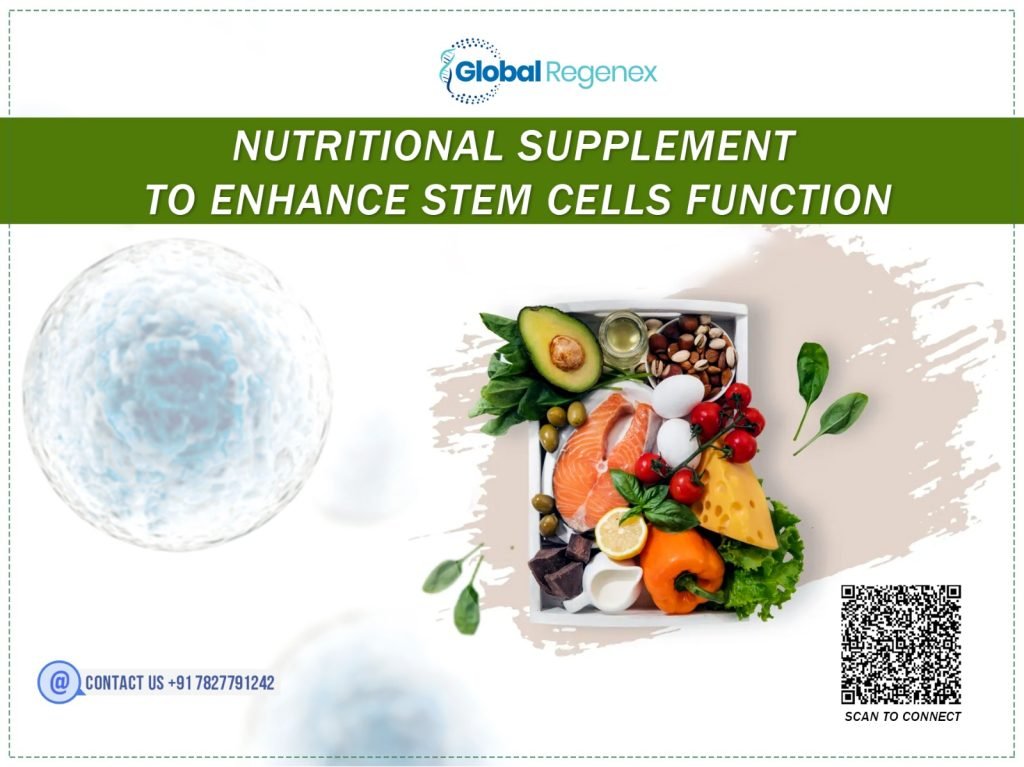
Do you ever wonder whether nutrition plays a role in determining how well stem cell therapy actually works? Obviously, the restoration of organs, tissues that have been damaged, and general health all depend very much on the presence of stem cells. So if this revolutionary way to cure all forms of problems offers you a chance to have your body in optimal health, then it will help the therapy work even better. The supplementing of proper nutrients will improve the function of stem cells, which in turn enhances their effectiveness and capacity for regeneration. If you are considering undergoing stem cell therapy in India, you can contact Global Regenex for further information. What are Stem Cells? Stem cells are the building blocks of the body that can differentiate into several cell types. They help in preventing diseases, regenerating tissues, and healing injuries. It becomes tough for the body to heal itself as we age because our natural stem cells are not as potent. In this regard, stem cell therapy has become very popular in India and is helping patients manage neurological problems, orthopedic ailments, and chronic diseases efficiently. Best Nutrients that Boost Stem Cells Function Several nutrients and supplements are proven to facilitate the proper working of stem cells and to further enhance the outcome of the stem cell treatment. These include the following to name a few of the best: Omega-3 Fatty Acids Fatty acids with omega-3 help differentiate the stem cells along with the process of anti-inflammatory activity. In this respect, it has become particularly beneficial in neuroprotection and cardiovascular health. Vitamin D Vitamin D is an element that helps keep the immune system and bones strong. It works to stimulate cell multiplication of the stem cells hence important in repairing bones and muscles. Curcumin (Extract of Turmeric) Curcumin has a rich anti-inflammatory as well as an antioxidant characteristic hence supports the creation and functioning of stem cells, it especially strengthens the brain as well as joint health. Resveratrol Resveratrol is an antioxidant found in red wine and grapes that increases the lifespan of stem cells and protects them from oxidative stress. EGCG (Green Tea Extract) Antioxidants in green tea protect stem cells from damage and enhance their regenerative potential. Amino Acids (L-Arginine and L-Glutamine) Amino acids are beneficial to healing after stem cell treatment as they are required for the immune system and cellular repair. Lifestyle Choices to Boost Stem Cells Function Apart from supplements, lifestyle choices are also very important for maximizing the function of stem cells. The following are some natural ways to increase the efficacy of stem cell therapy: Regular Exercise: Exercise, especially in the muscles and brain tissues, encourages the formation of stem cells. Intermittent Fasting: Studies have shown that the body produces new stem cells during fasting, which improves overall health. Good Sleep: The body promotes stem cell activity and cellular repair in case of proper sleep cycles. Decreasing Stress: Since chronic stress also inhibits stem cell activity, practicing mindfulness and relaxation can be beneficial. Stem Cell Therapy Revolutionizes Healthcare As regenerative medicine progresses, stem cell therapy in Delhi is being promoted as a treatment for various diseases. Autoimmune diseases, diabetes, neurological disorders, and arthritis have been the major areas where stem cell therapy has been showing some promising results. The appropriate diet and proper medical knowledge greatly increase the efficacy of the treatment. Final Verdict Healthy eating habits and good lifestyles can promote a better recovery for stem cell therapy. Supplements include omega-3, curcumin, and vitamin D. People who may choose to pursue stem cell treatment in Delhi are strongly advised to get the necessary input from experienced people. Global Regenex gives expert assistance regarding regenerative medicine, further advancing patients into their healthier life journey.
Is Bone Marrow Transplant 100% Successful?

Are you aware of how often bone marrow transplants succeed? These transplants are essential because they can significantly extend the lives of people dealing with blood disorders, cancer, and other severe illnesses. But can a bone marrow transplant ensure complete recovery? This is a critical question that many families face before starting treatment. In today’s blog post, we’ll delve into the answer to this question. For those looking into stem cell therapy in India, Global Regenex is a dependable company that guides the treatment process. What is Bone Marrow Transplant? Healthy stem cells are used in bone marrow transplants to replace damaged bone marrow. This drug is commonly used for a number of illnesses, including leukemia and other blood problems. There are two primary types of bone marrow transplants. Autologous Transplant: This type of transplant involves using the patient’s own stem cells. Allogeneic Transplant: In an allogeneic transplant, stem cells are taken from a different donor, typically a matched or family member. Factors Affecting the Success Rate of Bone Marrow Transplants Donor Matching: When donors and recipients are precisely matched, transplant success rates rise. Type of Illness: Transplantation is more feasible for certain illnesses than for others. Patient health: People who are in better health experience fewer problems and heal more quickly. Medical expertise: Transplant success is increased by knowledgeable personnel and cutting-edge medical treatment. Post-Transplant Care: Recovery requires medication, a healthy lifestyle, and routine examinations. Graft versus Host Disease (GVHD): The success rate of the transplant may be impacted if the donor cells assault the patient’s body. Bone Marrow Transplant Success Rate There are a number of factors that affect bone marrow transplant success rates. This is a synopsis: For leukemia patients, the success rate for early transplantation ranges from 60% to 90%. Timing is everything for better outcomes. Aplastic anemia patients have an 80% chance of finding a suitable donor among their siblings because of shared DNA. Autologous transplants, which use the patient’s own cells, have a 50% to 80% success rate for patients with lymphoma and multiple myeloma. Even with these encouraging statistics, problems including organ damage, infections, and more could affect the outcome of a bone marrow transplant. It is important to be mindful of these possible barriers during therapy, even though the odds may be in your favor. Need a Consultation? For the greatest outcomes, it’s important to speak with a specialist if you’re considering a bone marrow transplant or want to learn more about regenerative medicine. With cutting-edge procedures including bone marrow transplants and stem cell therapies, Global Regenex is a well-known brand in regenerative medicine. If you are thinking about getting a bone marrow transplant, get in touch with a specialist at Global Regenex for a better future and a greater chance of success. The Concluding Thoughts Though bone marrow transplantation is a powerful treatment option, it is not always successful. Patient health, post-transplant care, and donor matching are only a few of the many variables that significantly affect the outcome. Advances in medical research and expert consulting with companies like Global Regenex are leading to improvements in recovery outcomes and survival rates.
How Long Does It Take for Stem Cell Therapy to Work?
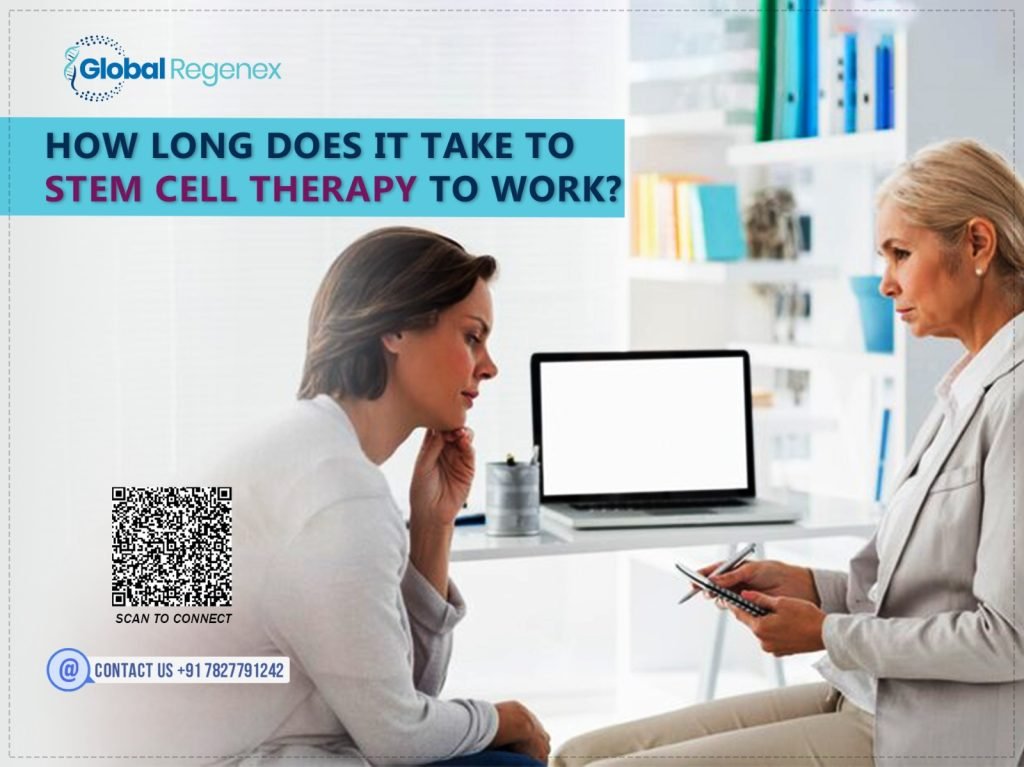
Stem cell therapy is possibly one of the most revolutionary techniques in treating multiple disorders and has come as a ray of hope for patients globally. But one of the nagging questions is always, how long does it take for stem cell therapy to show results? Knowing the timeline and extent of the effectiveness of stem cell therapy helps clear the expectations in the minds of people when thinking of the treatment option. If you would like to know about stem cell therapy in India, Global Regenex is your trusted partner in consultations and personalized treatments in regenerative therapy. Understanding Stem Cell Therapy Stem cell therapy is applied by virtue of utilizing regenerative potential, the body’s endogenous processes to repair damaged tissues, reduce inflammation, and restore functions. This almost magical therapy seems effective in treating arthritis, spinal cord injuries, neurodegenerative diseases, etc. In particular, stem cell therapy is considered a way to provide an effective and non-invasive treatment. Factors Affecting the Results of Stem Cell Therapy The effectiveness of stem cell therapy and the time required for working varies according to various factors of patients. These include: Nature of Condition Treated: Improvement times vary based on the severity of the condition treated. For example, someone may show improvements within a week if joint pain or soft tissue injury has occurred; in comparison, neurodegenerative disorders may take several months. The Overall health of the Patient: The effects of stem cell therapy will be impacted by such characteristics as a person’s age, the current health of his or her immune system, living habits, dietary habits, exercise patterns, and his or her potentiality in smoking. Number of Sessions Needed: When receiving treatment for chronic conditions, patients will require a number of sessions before any improvement can be considered noteworthy. Type & Quality of Stem Cells: The treatment’s efficacy is greatly influenced by the stem cells’ source, whether it be bone marrow, adipose tissue, or the umbilical cord, as well as the method used to collect them. Post-treatment Care: Adhering to recommendations which include physical therapy, medications, and a healthy lifestyle will accelerate healing and maximize results. Expected Timeline for Results Patients with stem cell therapy in India, including Delhi, should generally expect the following timeline: First Few Days to Few Weeks: Inflammatory response and pain relief, in some patients within days, especially orthopedic and musculoskeletal cases. One to Three Months: Most patients note functional improvement as the stem cells work to regenerate the damaged tissue. Three to Six Months: Some structural and recovery changes occur, which result in increased mobility and lessening symptoms. Six Months to One Year: Long-term advantages come to the surface as several patients report significant improvement in their quality of life. Looking for Professional Advice? Engage and consult with Global Regenex regarding your interest in stem cell therapy in Delhi or ask any questions related to regenerative medicine. It delivers a variety of the latest treatments for stem cells and professional advice for several medical conditions. Synopsis While some patients may feel relief right once, others may not see any changes for months. The effectiveness of stem cell therapy relies on a number of factors. Following post-treatment care recommendations and setting reasonable expectations are essential for the best results. See a professional to find out how stem cell therapy can help with your particular issue if you’re thinking about getting it in India. If you want expert consultation on stem cell therapy and personalized guidance, get in touch with Global Regenex, a respected name in regenerative medicine and consultancies.
How Are Stem Cells Different From Normal Body Cells?

Have you ever pondered about what makes stem cells so significant in medicine compared to other normal body cells? Stem cells contain a rare ability to differentiate into several body cell types and repair damaged tissues so that body cells can easily carry out their specialized tasks. Due to this, these cells have become very useful in contemporary therapies, like stem cell therapy. Many patients now have hope as a result of the usage of these cells to cure a variety of chronic illnesses and wounds, just because of the advanced research. If you are interested in stem cell therapy in India, Global Regenex is way perfect partner to learn more about this therapy. Understanding Stem Cells Stem cells are basically the building blocks of the human body. They have two key abilities that distinguish them from any other normal body cells: Self-Renewal: Stem cells can divide into different body cells and regenerate indefinitely. Differentiation: They can transform into specialized cells like muscle, nerve, or blood cells. On the other hand, unlike typical cells, which have a fixed role, stem cells remain unspecialized until needed. This ability allows them to repair and replace damaged tissues, providing immense power for medical treatments. Types of Stem Cells Stem cells are classified into different varieties in accordance with their potential to differentiate into several cell types: Adult Stem Cells: The adult stem cells can be found in such tissues as bone marrow and fat; they assist in the repair of damaged tissue but have limited power to differentiate. Induced Pluripotent Stem Cells: These cells are known as reprogrammed adult cells, which behave like embryonic stem cells, which is an alternative for research and therapy. Mesenchymal Stem Cells: These cells are also found in bone marrow and fat; they are widely used in regenerative medicine for the treatment of orthopedic and autoimmune conditions. Key Differences Between Stem Cells and Normal Cells Feature Stem Cells Normal Body Cells Function It can develop into various types of cells. It only performs a specific function. Division Ability It can divide indefinitely. Limited division potential Repair & Regeneration It has the ability to regenerate damaged tissues. It cannot regenerate extensively. Flexibility It can adapt to different cell types. It remains fixed in its function. Applications of Stem Cell Therapy Stem cell therapy involves a new and novel approach to repairing and regenerating damaged tissues rather than focusing solely on symptomatic treatment. Some predominant uses of stem cell therapy are as follows: Neurological Disorders: Treating conditions like Parkinson’s disease and spinal cord injury. Orthopedic Treatments: Bone and joint degenerative diseases and osteoarthritis. Cardiovascular Disease: Contributing to heart tissue regeneration. Diabetes: Restoring insulin-producing cells in juvenile diabetics. Need Expert Advice? Whether interested in stem cell therapy in Delhi or just looking to gain information in regenerative medicine, have full trust in Global Regenex as your consultant. They provide expert guidance and access to advanced stem cell therapy for a variety of medical conditions. The Bottom Line Stem cells are a boon to regenerative medicine because they potentially provide healing solutions for conditions once deemed untreatable. Unlike normal body cells, which have specific functions in the organism, stem cells have the ability to repair and reproduce differentiated tissues, an ultimate breakthrough in healthcare. With the numerous advancements in stem cell therapy, patients are beginning to enjoy effective minimally invasive treatments. Should you wish to delve into regenerative medicine, consult Global Regenex to find all the best options for stem cell therapy.
Why is Stem Cell Treatment So Vital These Days?

It was a medical miracle in the recent past with the groundbreaking cures brought by stem cell therapy for diseases that were thought to be incurable. With the advancement of medical science, now millions of patients around the world are experiencing its innovative method. What is the exact thing that makes the modern world care for stem cell therapy? Let’s dive in further into how revolutionary this new treatment is, which is important to understand about contemporary health. Understanding Stem Cells Stem cells are those cells that build life and distinguish easily from all other body cells due to self-renewal features and also due to their ability to differentiate into virtually all types of differentiated cells, starting from muscle and nerve to blood cells. For this reason, they are significant in the process of disease prevention as well as in the repair of tissues. Types of Stem Cells Stem cells are interesting because of the wide range of cell types they can differentiate into during early life and growth. There are many different types of stem cells, and each has unique characteristics and functions. Adult Stem Cells: Many tissues of the human body consist of adult stem cells. These are differentiated far more than the embryonic stem cells. Thus, they have the ability to differentiate into very few cell types that are only characteristic of their tissue of origin. For instance, hematopoietic bone marrow stem cells can differentiate into several types of blood cells. Induced Pluripotent Stem Cells (iPSCs): These adult cells have been genetically reprogrammed to look like embryonic stem cells. They are pluripotent, meaning they can differentiate into any kind of cell, just like embryonic stem cells. The Importance of Stem Cell Therapy in the Current Era Revolutionizing the Treatment of Chronic Diseases Medications and lifestyle changes have been the mainstay of chronic diseases such as diabetes, heart disease, and arthritis, but they are hardly ever cured. Let’s discuss stem cell therapy. This treatment addresses the root cause of diseases by repairing damaged tissues, offering relief and recovery rather than just managing symptoms. Neurodegenerative Diseases There is much suffering of patients and their families with diseases like Parkinson’s, Alzheimer’s, and spinal cord injuries. The prospect of nerve cells regenerating from stem cells offers the promise to turn back the damage and improve life quality in such patients, whereas treatments with traditional approaches only slow the progression. Healing Faster from Injuries Stem cell therapy is utilized by athletes and people with musculoskeletal injuries so that they could recover quickly. These therapies will allow patients to heal on their own, replacing cartilage, tendons, and ligaments without invasive procedures or protracted recuperation times. A New Source of Hope for Cancer Patients Along with cancerous cells, chemotherapy and radiation treatment often damage healthy tissues. Cancer patients are able to recover and become stronger due to the regenerative process of healthy blood cells by using stem cells, especially in bone marrow transplants. Fighting Aging with Regenerative Medicine As the world ages, preserving quality of life is very important. The use of stem cells is increasing in anti-aging treatments, including skin rejuvenation and the regeneration of internal organs. This technique combats age-related diseases as well as aesthetic problems. Versatility of Stem Cells Therapy The applications of stem cell therapy are constantly developing. Its adaptability is the best, where it can treat genetic disorders as well as encourage organ regeneration. It is a personalized approach; its treatments often become customized based on the patient’s specific condition so that the effects may be produced. Need Consultation? If you are considering stem cell therapy or want to know more about its benefits for a specific disease, expert consultation is a must. Global Regenex is a well-known brand in this field, offering individualized guidance tailored to your specific needs. Whether you wish to control a chronic condition, recover from an injury, or explore regenerative anti-aging options, their experience ensures you are in good hands. Summarization Current medical practice is changing because of stem cell therapy. The ability to regenerate, repair, and rejuvenate tissues for the treatment of numerous health issues makes it revolutionary. With ongoing research, stem cell therapy seems to have a more promising future than before. Be it an improvement in quality of life or fighting a crippling disease, this pioneering treatment might just be what you’ve been searching for. With professionals like Global Regenex on board, the options are endless.
Which Is The Best Consultancy For Stem Cell Therapy In India?
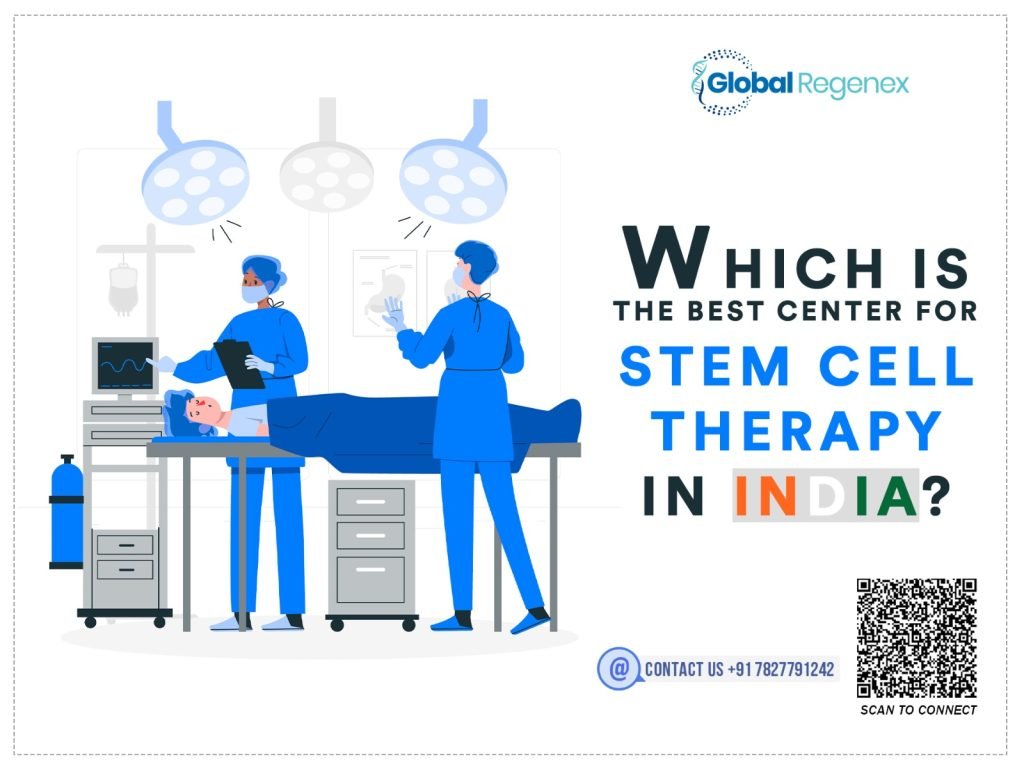
Stem cell therapy, which gives hope to many seemingly incurable diseases by simply letting the human body replace, repair, or even rejuvenate those damaged tissues, is considered the most revolutionary type of medical practice, completely changing the whole healthcare industry. You would then need the solid and effective cooperation of a reliable and resourceful consulting service that could suggest only the very best stem cell therapy in India to you. To help you in making the right decision, this blog explores some of the top consultancies on stem cells and stem cell therapy. Understanding Stem Cell Therapy Being unique in their characteristics, whereby they can differentiate into different types of cells to heal damaged tissues, stem cells make for a rare medical treatment. Such characteristics in stem cells help in treating diseases like neurological disorders, arthritis, and even cancerous conditions. Non-invasive procedures and their growing success rate have made stem cell therapy quite popular in India. However, proper selection of consultants ensures safe and effective treatment. Top Stem Cell Therapy Consultancies in India Global Regenex Global Regenex is one consultancy that aims to provide the best stem cell therapy services. Their commitment to quality and innovation has made them a leading brand in the industry. From autoimmune disorders to osteoarthritis, Global Regenex provides treatments. By ensuring that treatments meet the highest international standards, they put patient safety first. They provide individualized treatment with a staff of knowledgeable experts according to the needs of every patient. Global Stem Cell Therapy Global Stem Cell Care is the leader in stem cell therapy consulting. It has developed a patient-centric approach in its methodology. Its services range from consultation to aftercare. Global Stem Cell Care has helped countless patients regain their health through cutting-edge technology and individualized guidance. They provide the best quality care and professional expertise in diseases such as Parkinson’s disease, liver diseases, and spinal injuries. Stem Cell Care India The leading names in the field include Stem Cell Care India. Such consultancy offers innovative treatments through stem cell therapy for many illnesses, including diabetes, multiple sclerosis, and autism. Such consultancy is reliable for patients looking into advanced medical treatments because they work with skilled professional doctors and maintain modern facilities. They ensure that the patients are kept aware of their treatment plans by their clear pricing and extensive consultation procedures. Viezec Viezec is very famous for its affordable and effective stem cell consultancy. Patients from all over the world have learned to rely on them as they have more than enough certified hospitals with experienced specialists. They focus on putting up effective results of the treatment by using state-of-the-art research and advanced techniques. Viezec specializes in handling neurological, cardiovascular diseases, and orthopedic disorders. Their robust infrastructure and reach across the globe make it a strong contender in the market. The Concluding Thoughts It’s a revolutionary decision for those people who are opting for the next-generation treatment for long-term ailments. India is now a leading global hub, and consultancies like Global Regenex along with other such consultancies are at the forefront. There is no comparison between each and every consultancy in terms of individual benefits, so if you look for the combined benefit of having the latest technological advancements, patient-centric attention, and some tested results as well, Global Regenex is a wonderful option. Begin this path to recovery and wellness by speaking with professionals who value your health and well-being. A healthy future with stem cell therapy is something more than a cure!
How Successful Is Autologous Stem Cell Transplant for Multiple Myeloma?
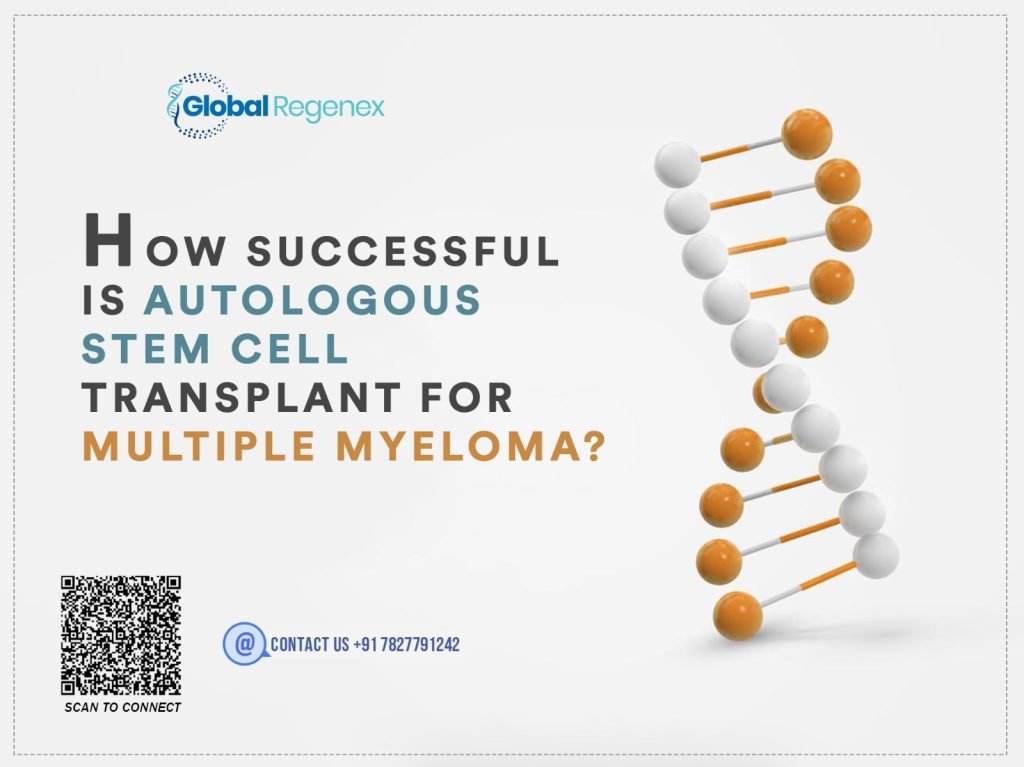
Autologous stem cell transplant is the most significant plasma cell attack that diagnoses blood cancer called multiple myeloma. Many patients and caregivers are confused about whether using the treatment for multiple myeloma is a good decision or not, so let’s go through some facts that may provide better knowledge on how ASCT stem cell treatment impacts normal life for those patients and what the level of success achieved. What is Autologous Stem Cell Transplant? A high dose of chemotherapy due to the required treatment would necessitate the process of autologous stem cell transplant, whereby a patient’s stem cells replace the damaged bone marrow; it resets the production of healthy red blood cells, white blood cells, and platelets. The patient’s prechemotherapy stem cells are harvested, stored, and subsequently reinstated following treatment. After chemotherapy has impaired the bone marrow by killing the cancerous cells, autologous stem cell transplants recover healthy blood cell production in multiple myeloma patients. This therefore enhances general health and recovery. How Does Multiple Myeloma Benefit from Stem Cell Therapy? There are two parts of stem cell therapy that go into treating multiple myeloma: High-Dose Chemotherapy Support: In many cases, the chemotherapy administered to attack myeloma cells damages the bone marrow. The infusion of stem cells following treatment helps the bone marrow to repair itself more rapidly and to maintain normal blood production. Long-term Remission Periods: Patients are more likely to have longer periods of remission after undergoing autologous stem cell transplants. This reduces the pace of disease progression and improves the overall survival rate. Success of Multiple Myeloma Autologous Stem Cell Transplant A number of individual factors influence the success of ASCT, for example, age, general condition, and stage of multiple myeloma. On the contrary, a number of research studies and clinical trials indicate optimism: Extended Survival: It has been seen that ASCT significantly improves survival in comparison to standard treatments. A number of patients are able to achieve progression-free survival of two to three years after the transplantation, and some even more. Better Quality of Life: After the treatment of ASCT, patients regularly complement their much improved physical as well as psychological condition. Such therapy, through the reduction in the frequencies of treatments, relieved them from hectic chemotherapy. Deeper Treatment Outcome: Alongside maintenance drugs as well as other targeted therapies, ASCT ensures that patients undergo deeper results, which include MRD negativity. Patients achieve such a negative status when they do not even have a cancerous cell that can be detected. Eligible for stem cell transplant? A person’s eligibility for an autologous stem cell transplant is determined by the type and stage of the disease, general health, and special medical requirements. The following are general factors: Type of Disease: ASCT is commonly utilized in diseases like lymphomas, multiple myeloma, and some forms of leukemia. Stage of the Disease: Those individuals with responsive or early-stage diseases are often considered to be ideal candidates. General Health: Organ function and performance are of the utmost importance. Previous Treatments: Eligibility may be influenced by the results of previous treatments as well as the absence of significant residual disease. It all depends on having a doctor such as Global Regenex who can understand your specific situation and provide advice appropriate to your situation. The Bottom Line A successful and increased survival rate with quality life is achieved in autologous stem cell transplantation for multiple myeloma by restoring normal blood cell production. Even though there are factors individually influencing its success, research does show promising results. Eligibility is decided based on the kind, stage, and general health of the disease. Contact Global Regenex for individualized guidance on ASCT suitability and potential advantages.
How Does Fasting Affect Stem Cells?
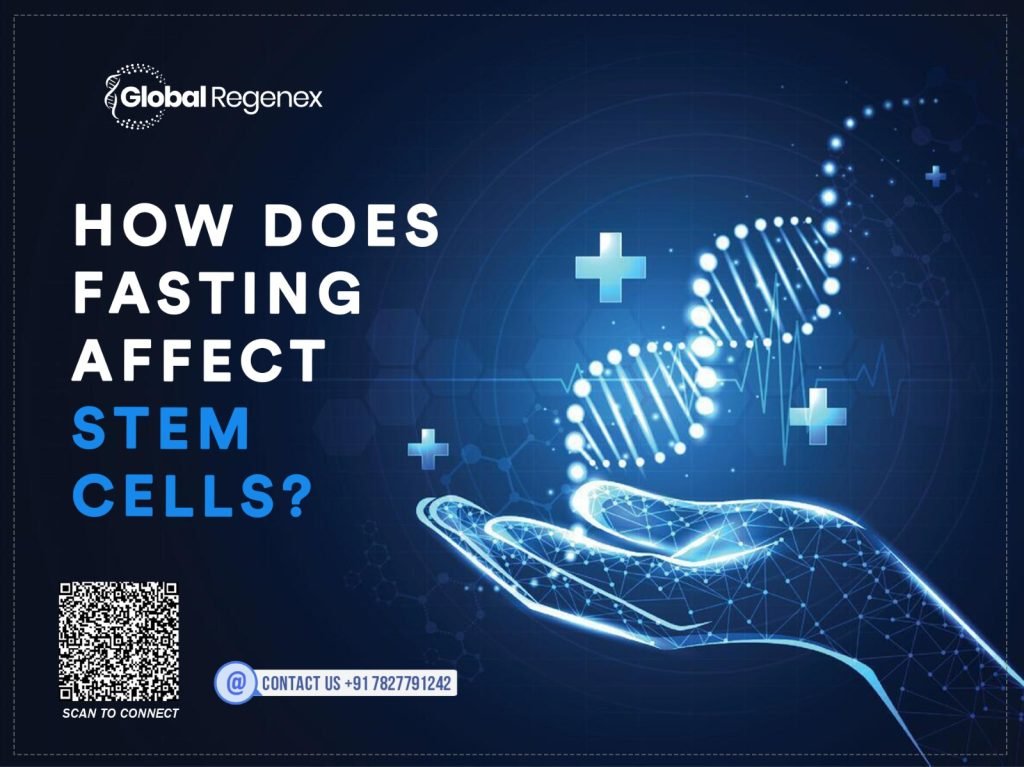
Fasting has been gaining popularity in diet circles recently for its potential health benefits, such as improved metabolic health and weight loss. But out of all research areas, it is probably most interesting how fasting impacts stem cells—the body’s building blocks for regeneration and repair. Because these cells are so important to the maintenance and repair of tissues, their central theme emerges as stem cell therapy dealing with aging, chronic diseases, and wounds. So, let us delve into this relationship between stem cells and fasting and how this may alter health and well-being. What Are Stem Cells? Stem cells are those cells that build life and distinguish easily from all other body cells due to self-renewal features and also due to their ability to differentiate into virtually all types of differentiated cells, starting from muscle and nerve to blood cells. There are two main types: Adult stem cells: These are found in specific tissues, and they assist in the maintenance and repair of those tissues. Induced Pluripotent Stem Cells (iPSCs): Genetic reprogramming makes these adult cells look like embryonic stem cells. They, like embryonic stem cells, can become any type of cell because they are pluripotent. Fasting essentially changes the function of adult stem cells located in the brain, gut, and bone marrow to proliferate and function. The Science Behind Fasting and Stem Cells Studies on the relationship between stem cells and fasting hold much promise in terms of delivering longevity and improving health benefits. The key conclusions drawn from this are summarized below: The Effect of Fasting on Stem Cells Metabolic Switch: When one is fasting, the body starts acting on body fat as the primary source of energy rather than glucose. This metabolic switch improves the function of stem cells and encourages cellular repair processes. mTOR Pathway: The mTOR pathway is relatively less active during fasting. This makes it easier for the maintenance of stem cells. The hematopoietic stem cells that are very pivotal in blood cell regeneration have relatively high capacities of regeneration when mTOR signaling is lowered by fasting. Induction of Autophagy: The process of cell elimination of damaged parts to allow for healthier cells is induced by fasting. This helps in maintaining a healthy population of stem cells. Ketone Bodies: Blood contains more ketone bodies in the fasting state, which are an alternative energy source and facilitate the growth and differentiation of stem cells. Benefits of Fasting on Stem Cells Regeneration: Fasting increases the regeneration capacity of stem cells, thereby helping tissues recover from inflammation or damage. For example, it has been shown that fasting increases the regeneration capacity of intestinal stem cells. Healthspans: Low-calorie diets and intermittent fasting have been linked to longer lifespans in many organisms and the later onset of age-related diseases. Personalized medicine: Fasting may be an effective therapeutic strategy in age-related disorders to promote tissue homeostasis and regeneration. Are You a Good Fit for Fasting? Although there are numerous benefits to fasting, no one person is the same. Some health conditions, certain medications, or being pregnant do not allow a person to fast for extended periods. First and foremost, any form of fasting regimen should first be consulted with a healthcare professional. Final Verdict Stem cell repair and regeneration will be enhanced when fasting is applied together with the current stem cell therapy, making it a wonderful treatment for healing and rejuvenation. It contributes to gut health, cognitive improvement, and the well-being of the immune system. Consult Global Regenex for personalized stem cell therapy. They have state-of-the-art treatments and care tailored to the needs of individuals to fully apply the use of stem cells toward a healthier, more energetic life. Begin transforming now!
Does Stem Cell Transplant Cure Alpastic Anemia?
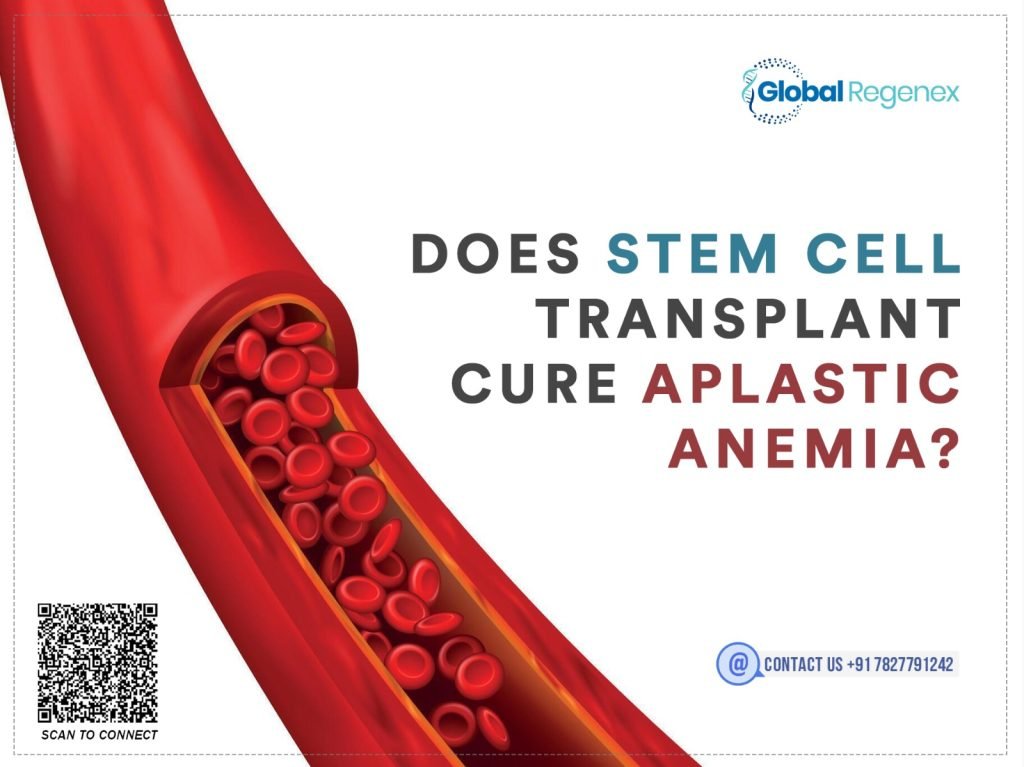
Aplastic anemia is a rare condition where there is failure of the bone marrow to produce adequate blood cells. It usually has aspects associated with fatigue, infections, and bleeding. Medicines and blood transfusions may correct some problems for a short time but will not cure the main problem. Stem cell therapy, especially transplants, is so appealing to many patients since it can cure the condition and restore normal blood cell production. The effectiveness of stem cell therapy and the impact on patient lives can be seen in the science itself. What Is Aplastic Anemia? Aplastic anemia is the production of inadequate numbers of red and white blood cells, and sometimes platelets, in the bone marrow. This illness is often related to autoimmune disease, toxins, infections, and genetic influences. Some manifestations of the signs are bruising easily, prolonged bleeding, frequent infection, and fatigue. This can be deadly if untreated. How Do Stem Cells Work? Stem cells are important because they can become different types of cells, like blood cells. The body uses them as its main cells. Stem cells are mainly found in the bone marrow and umbilical cord blood, and they are key for treatment. Once they are put into the body, they can fix or replace damaged organs or tissues. What’s a Stem Cell Transplant Process Like? In a stem cell transplant for anemia, healthy stem cells from a donor are used to replace the patient’s damaged bone marrow. A number of steps involved in the process are: Therapeutic Conditioning: Radiation therapy or chemotherapy is administered before the transplant to destroy the defective bone marrow. Stem Cell Infusion: A matched donor’s healthy stem cells are introduced into the patient’s circulation. Embraftment: After the transplanted stem cells have reached the bone marrow, healthy blood cells are produced. Monitoring and Recovery: The patient is closely monitored in case of complications such as infections or graft-versus-host disease (GVHD), where the donor cells attack the tissues of the patient. Is Stem Cell Transplant a Cure? A successful transplant can alter the lives of most of the patients with severe aplastic anemia. While scientific evidence demonstrates that, in most cases, the procedure maintains patients’ health for a long time or results in complete recovery, there are several factors inhibiting it from curing the disease: Donor Match: The chances of success are higher if the HLA on the recipient and that of the donor match closely. Age of the Patient: Generally, younger patients do better with transplants than older patients. General Health: The greater the overall health of a patient, the more likely the patient is to recover fully. Stem Cell Therapy for Aplastic Anemia Stem cell therapy can treat a range of diseases and disorders, and recent advancements in medical science have shown that this treatment can even treat aplastic anemia. It does this by replacing the damaged bone marrow with healthy stem cells, restoring healthy blood cell production, improving quality of life, and providing long-term remission. It is particularly useful for patients who do not react well to immune-suppressive drugs. Putting All Together Although carrying out stem cell transplants will pose a degree of risk over the treatment’s benefits, that is especially considering the severe degrees of aplastic anemia. Global Regenex provides individuals with personalized forms of stem cell therapy. Through professional consultation, recovery support, and more, such a strategy holds the potential and signifies the breakthrough from stem cell treatments. Investigate this therapy and stop aplastic anemia from taking over your life.
What is the Success Rate of Stem Cell Therapy for the Eye?
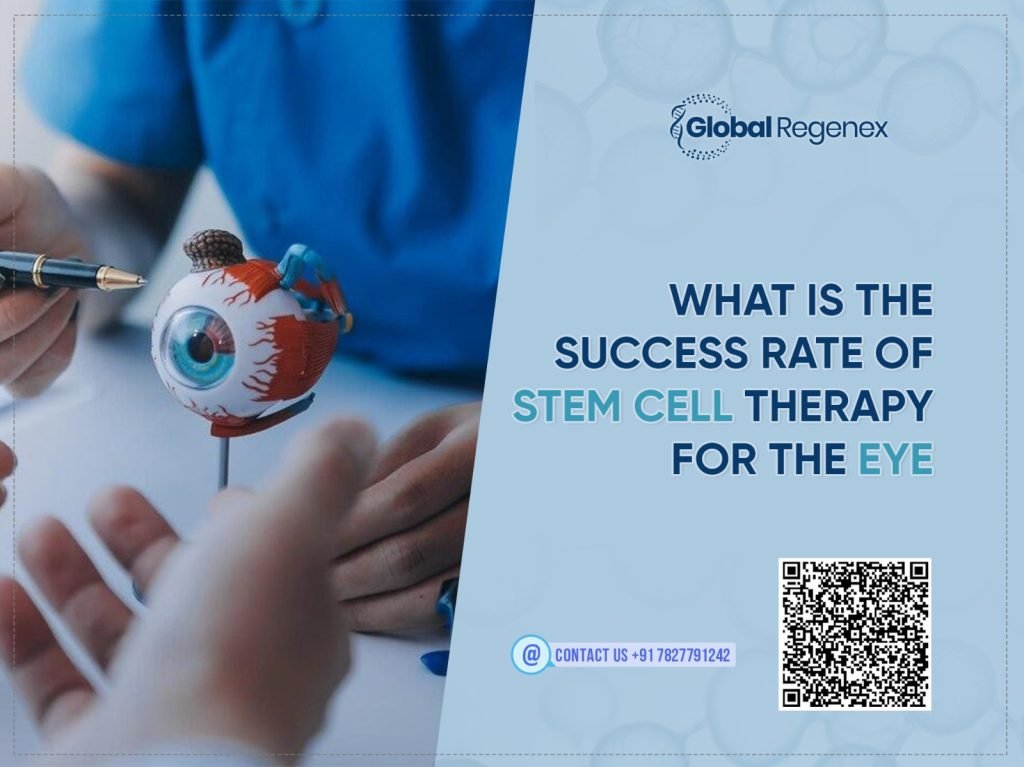
Stem cell treatment is revolutionizing the very foundation of medicine, raising hopes for patients who considered previously incurable conditions out of their reach. Such revolutionary treatment has various applications among them is the healing capacity that stem cell therapy imparts to eye injuries and further heals damage to the eyes. stem cell therapy success rates for eye issues Here, we will discuss eye-related conditions treated with stem cells and understand how Global Regenex may be able to get you through this transformation. Understanding Stem Cells and Their Role in Eye Health It has such differentiating properties that have made the most of stem cells invaluable for the realm of regenerative medicine. For eye health, such unique cells can replace damaged retinal cells promote corneal tissue regrowth, and restore critical parts of how stem cell therapy works for the eye. In a tissue regeneration sense, this aspect gives hope to people experiencing blindness or highly detrimental eye conditions. How Stem Cell Therapy Works for the Eye? This involves using special cells capable of growing into any form of tissue in the body. These include cells that exist within the eye; they are introduced into the damaged region to start healing and regrowth. In such cases of eye injuries, it heals the cornea retina, and many other vital parts of the eye responsible for vision. Some of the most used stem cells in eye treatment are: Adult Stem Cells: They are found in tissues like bone marrow and are notorious for their regenerative potential. The most common kind of bone marrow transplant employs adult stem cells. Induced Pluripotent Stem Cells (iPSCs): Adult cells reprogrammed to behave like embryonic stem cells can be used to personalize therapy. Advantages of Stem Cell Therapy for Eye Conditions Compared to conventional treatments, stem cell therapy has many advantages. These include: Minimally Invasive: It is less invasive than surgery and hence has a reduced recovery period and possible complications. Regenerative Ability: The natural healing process is enhanced through repairing tissues rather than mere symptomatic treatment. Personalized: It uses cells belonging to the patient itself, such as in bone marrow transplantation, to avoid rejection. Longer-term Benefits: Most patients benefit from permanent improvement in their vision and eye health. Success Rate of Stem Cell Therapy for Eyes There are promising success percentages indicated in the research about clinical trials that have indicated an ability to treat ophthalmic injuries and damage resulting from it. The numbers, of course, vary relative to the type of condition diagnosed and the kind of stem cell used but range between 60-80 percent improvement in terms of vision and tissue reconstruction. For example, patients with corneal injuries who were treated with stem cell transplant have reported significant improvements in vision and reduced symptoms. Similarly, patients with retinal degeneration have reported better light sensitivity and visual acuity following treatment. The Concluding Thoughts Stem cell therapy is revolutionizing the way of treating eye injuries and damage, giving new hope to people who, a few years ago, could hardly do anything. Some cases are treated with an efficiency rate of up to 80%. If you or a loved one are contemplating using stem cell therapy to treat damage in your eyes, contact experts like Global Regenex, and ask about your possibilities. Their care for patients will be the assurance of placing you in very capable hands, and so, hopefully, back on your way to better vision and healthier eyes.
